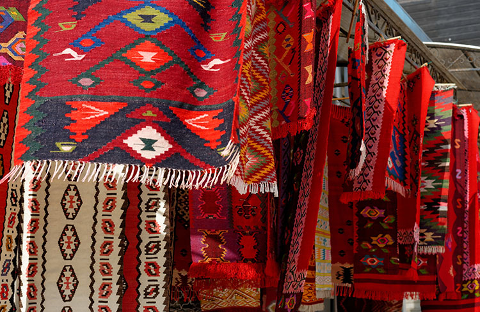Kilim - One of the oldest types of rug weaving
This rug weaving art known from ancient times, made and used by nomads living on livestock in Central Asia, the Caucasus, Anatolia, and Iran.
All around the world in different regions there are differing techniques and styles that come about through tradition and a way of conveying messages and desires through the art of tapestry weaving. Kilim is a word of Turkish origin that relates to the style of weave and style of geometric motifs and symbols displayed in their work.
Kilim is used to describe a tapestry-woven textile with brilliant colors that display geometric designs that use a patterned flat weave technique. They are pileless rugs that have many uses and have unique features representing the regions and the makers of these fine pieces of art.
Image credit: https://goturkiye.com/blog/the-5-most-common-anatolian-motifs-and-their-meanings
The patterns and motifs are specific to the regions and townships they are made in and have been used historically to communicate a message through art. Sometimes the patterns and motifs are designs to guard against certain things or to attract or ask for certain things. A widely used motif is the elibelinde, of a woman with her hands on her hips as a stylized female figure, evoking fertility and motherhood, whilst the eye shape motif represents a hope for the safety of the weaver's family to guard against the evil eye or envy of others. When these things are woven into rugs, they are like an amulet believed to communicate protection or bring about a desire with the symbol. They tell a story of the people's land and traditions which can be interpreted and shared through this way of communication.
Female Figure
Eye Motif
Not only are these pile-less pieces of art used for rugs because they have no pile and a flat weave structure, they can be used as bedclothes, tablecloths, cushions, curtains, bags and really whatever your imagination thinks you could use them for. They are lighter and more pliable than a pile rug giving them more flexibility in use.
Image Credit https://www.kilim.com
A lot of these pieces have not changed in style or design unlike the other weave methods where pile rugs were made and exported to other countries, adapting to what style and designs where requested and desired.
This has allowed for the Kilim rugs to maintain a strong tradition of passing down the historic art of the technique with symbols, motifs, and colours. As with a lot of traditional rug making that is very labour intensive. There is a dwindling amount of people these skills are being passed down to. Traditionally the art is taught to girls who are choosing to go to school and work in different areas.
Image Credit: LoggaWiggler via Pixabay
The materials used for these often brightly coloured pieces of work are generally made from natural fibres such as wool and angora goat that are from the region. The animals are sheared, the yarn washed, carded, spun, and dyed with natural dyes from plants or materials such as bark from the land. These berries or plants can sometimes take days to harvest, making this an exceptionally long and labour-intensive process.
The colours and motifs are a direct correlation to the region they come from as certain regions will create differing colours and patterns reflecting the natural resources available and knowledge of how to dye with that plant matter. After the rugs are woven, they are often laid out to solarise allowing the colour to last for years to come.
Image Credit https://www.kilim.com
Kilims are generally done with a slit weave technique, the slit is the gap between the two-colour blocks, created by the returning weft around the last warp in that colour and the other colour adjacent is later returned around the adjacent warp.
These beautiful timeless designs are all individual pieces of textile art, communicating tradition and culture via a language of motifs, symbols and colourful expressions for all to appreciate. With more applications of use, the double-sided weave allows these rugs or woven textile pieces of work to be used for so many applications. With not too many naturally dyed rugs being made these are truly timeless pieces of work.






